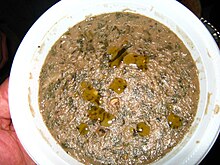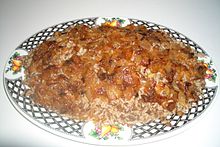List of Palestinian dishes

A typical Palestinian breakfast with pita, olives, tomatoes, fried egg, and labaneh
The following is a list of Palestinian dishes. For the cuisine, see Palestinian cuisine (Arabic: الطعام الفلسطيني),
The cultural and linguistic heritage of the Palstinian people is a blend of both indigenous Canaanite, and the Phoenician elements and the foreign cultures that have come to rule the land and its people over the course of thousands of years
Main dishes by region[]
Galilee[]
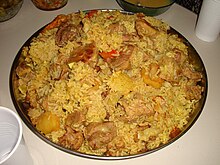
Maqluba
- Kebab halabi—kebab served with a spicy tomato sauce and Aleppo pepper
- Kibbeh
- Kibbee bi-siniyyeh—
- Kibbeh nayyeh—
- Mansaf
- Maqluba—an "upside-down" dish, made with fried vegetables, meat (lamb), rice and eggplant
- Musakhan—large taboon bread topped with sumac, and onions
- Ruz wa Lahme ma' Laban—mix of rice and lamb topped with a mildly spicy yogurt[1]
- Shish taouk—chicken pieces on skewers
West Bank[]
- Fasoulya beyda—white beans cooked in tomato sauce and served with rice
- Fasoulya khadra—green beans cooked in tomato sauce and served with rice
- Kafta b'thine—kafta balls cooked with tahini sauce[clarification needed] and served with rice
- Kafta harra—kafta cooked in tomato sauce with potatoes, eaten alone or in pita bread
- Mahshi lift—a specialty of Hebron, turnips stuffed with rice, minced lamb meat and spices, cooked in tamarind sauce[2]
- Mandi or Ruz ma lahma—in the West Bank, made by cooking meat, rice and vegetables in a taboon, as in other Arab States
- Mansaf—lamb cooked in a sauce of fermented dried yogurt and served with rice or bulgur
- Maqluba—an "upside-down" dish, made with fried vegetables, meat (chicken/lamb) and rice
- Musakhan—large taboon bread topped with sumac, onions and peppers
- Zarb—same as mandi, but cooked under high pressure in an airtight oven, and usually rice is substituted by bread (influenced by Jordanians)
Gaza[]
- Fukharit 'adas—lentil flavored with red peppers, dill, garlic and cumin
- Maqluba—upside-down eggplant, rice, meat and cauliflower casserole
- Qidra—rice and meat pieces cooked with cloves, garlic and cardamom
- Rummaniyya—a mix of eggplant, pomegranate seeds, tahina, red peppers and garlic[3]
- Sumaghiyyeh—beef and chickpea stew flavored with sumac, tahina and red peppers
- Zibdieh—a clay-pot dish of shrimp baked in a stew of olive oil, garlic, hot peppers, and peeled tomatoes
National[]
- Ari'ih—rice and minced meat stuffed in pumpkins
- Bamia—okra cooked with tomato sauce and onions
- Falafel—fried hummus, spice and parsley ball or patty
- Fatta—dishes that include bread crumbs
- Hummus—a dip, spread, or savory dish made from cooked, mashed chickpeas blended with tahini, lemon juice, and garlic
- Kousa mahshi—rice and minced meat stuffed in zucchini
- Maftul—large couscous-like balls, garbanzo beans and chicken pieces cooked in chicken broth
- Malfuf—rice and minced meat rolled in cabbage leaves
- Maqluba—upside-down eggplant, rice, meat and cauliflower casserole
- Mloukiyyeh—Corchorus stew
- Mujaddara—lentil and bulgur casserole
- Musakhan—large taboon breads with chicken, onions, sumac, and allspice
- Shawarma—a dish consisting of meat cut into thin slices, stacked in a cone-like shape, and roasted on a slowly-turning vertical rotisserie or spit
- Shurbat freekeh—green wheat soup, usually with chicken
- Waraq al-'anib—rice and minced meats rolled in grape leaves
Side dishes[]
Salads and dips[]
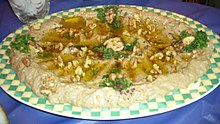
Baba ghanoush

Tahini with lemon and garlic

Galayet bandora
- Arabic salad—made of tomato, cucumber, onion, olive oil and lemon juice, Palestinian variant called Salatat al-bundura ("tomato salad")
- Baba ghanoush—aubergine (eggplant) salad
- Hummus—ground chickpeas with tahina and olive oil
- Fattoush—mixed leaf-vegetable salad with deep-fried pita bread pieces and sumac
- Ful medames—ground fava beans and olive oil
- Galayet bandora—a simple dish of tomatoes, onions, hot peppers, olive oil, and salt served for breakfast, lunch, or dinner
- Malfouf salad—typically consists of shredded cabbage, lemon juice, olive oil, garlic, salt and dried mint
- Mfarakeh—a dish made of potato, egg, ghee, cumin powder, salt and pepper, in addition chopped coriander leaf for garnish
- Mutabbel—spicier version of baba ghanoush
- Tabbouleh—parsley and bulgur salad with diced tomatoes, onions and lemon juice
- Tahini—condiment made from toasted ground hulled sesame seeds
Cheeses and yogurts[]
- Akkawi—a white brine cheese originating from the city of Akka, Palestine*
Halloumi—cheese with a high melting point which can easily be fried or grilled, making it a popular meat substitute
- Jibneh Arabieh—has a mild taste similar to feta but less salty
- Jameed—a hard dry laban made from ewe or goat's milk, kept in a fine woven cheesecloth to make a thick yogurt
- Kashk—made from drained yogurt or drained sour milk by shaping it and letting it dry
- Labeneh—tangy, thick, creamy yogurt cheese
- Nabulsi—can be eaten fresh as salty table cheese or can be fried in oil
Breads[]

Markook

Pita in Nablus
- Ka'ak—may refer to a bread commonly consumed throughout the Near East that is made in a large ring-shape and is covered with sesame seeds
- Khubz—may refer to any type of bread. Breads popular in Arab countries include "pocket" pita bread and tandoor bread. The oldest known find of bread, by archaeologists in Northern Jordan, dates back 14,000 years
- Pita—a family of yeast-leavened round flatbreads baked from wheat flour, common in the Mediterranean, Middle East, and neighboring areas
- Markook—unleavened and usually made with only flour, water, and salt, and after being rested and divided into round portions, flattened and spread across a round cushion until it is thin then flipped onto the saj
- Taboon—an important part of Palestinian cuisine, traditionally baked on a bed of small hot stones in the taboon oven
Bread dishes[]
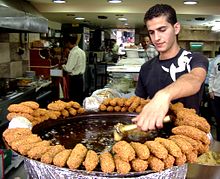
A Palestinian man from Ramallah using an aleb falafel while frying falafel
- Fatayer—a meat pie that can be stuffed with spinach, or cheese such as feta or Akkawi, and za'atar
- Manakish—taboon bread topped with za'atar and olive oil
- Sambusak—fried dough balls stuffed with meat, pine nuts and onions
- Sfiha—flatbread topped with beef and red peppers
- Shawarma—pita bread roll of meat, tahini and various vegetables
Condiments[]
- Bahārāt (بَهَارَات)—Arabic word for "spices" (plural of bahār "spice")
- Duqqa (دُقَّة)—a condiment consisting of a mixture of herbs, nuts (usually hazelnut), and spices
- Qizha (قزحة)—made from crushed nigella seeds, the paste has a sharp, bitter taste with slight tones of sweetness
- Sumac (السماق)—ground into a reddish-purple powder used as a spice in Middle-Eastern cuisine to add a tart, lemony taste to salads or meat
- Za'atar (زَعْتَر)—a spice mixture that includes the herb along with toasted sesame seeds, dried sumac, and often salt and other spices
Beverages[]
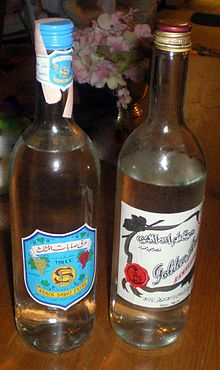
Palestinian arak
- Arabic coffee—a version of the brewed coffee of Coffea arabica (بُنّ) beans
- Arak (ﻋﺮﻕ)—Anise-flavored alcoholic beverage
- Helba (حلبه)—Fenugreek beverage
- Kharroub (خَرُّوبٌ)—carob juice
- Lemonade (عصير الليمون)—a sweetened lemon-flavoured beverage
- Qamar Eddine (قمر الدين)—an apricot juice or nectar beverage that is typically consumed during the Muslim holy month of Ramadan
- Sahlab (سَحْلَب)—boiled milk with starch made from nearly-extinct orchids, covered with smashed coconut and cinnamon
- Tamar Al-Hindi (تمر هندي)—a refreshing cold sweet-and-sour Ramadan drink prepared with tamarind, sugar and water
- Turkish coffee (قهوة تركية)—a style of coffee prepared using very finely ground coffee beans without filtering
- Zanjabeel (زنجبيل)—a simple ginger tea
Sweets[]
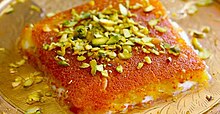
Kanafeh
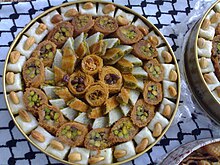
Baklawa from Nablus

Awameh
- Awameh (عوامة)—Arabic for "swimmer", a Levantine pastry similar to doughnut holes, made of deep-fried dough, soaked in sugar syrup or honey and cinnamon, sometimes sprinkled with sesame
- Baklava (البقلاوة)—sweet pastry made of layers of filo
- Batata b'kaak (فطيرة البطاطس)—potato pancake
- Ghoriba (غريبة)—a shortbread biscuit, usually made with ground almonds
- Halawa (حلوى)—primary ingredients are tahini and sugar, glucose or honey
- Harīsa (هريسة)—a traditional semolina sweet cake drenched in rose water
- Kanafeh (كُنافة)—cheese pastry soaked in sweet sugar-based syrup
- Ma'amoul (معمول)—shortbread pastries filled with dates, pistachios or walnuts
- Maftoul (مفتول)—small steamed balls of crushed durum wheat semolina usually served with a stew spooned on top
- Meshabek (مشبك مصري)—Egyptian funnel cake
- Muhallebi (مهلبية)—a milk pudding, basic ingredients are rice, sugar, rice flour and milk
- Qatayef (قطايف)—sweet dumpling filled with cream or nuts
- Saḥlab (سَحْلَب)—a flour made from the tubers of some near-extinct species of the orchid genus Orchis, used to make mucilaginous hot drinks and desserts; now many instant sahlab mixes are made with artificial flavoring since the true form is illegal
- She'reyabil haleeb (شعريه)—rice vermicelli in milk, very similar to rice pudding, but with less milk
- Warbat (وربات)—a sweet pastry similar to baklava, with layers of thin phyllo dough filled with custard
See also[]
Palestine is one of The Levant Countries, Which are Syria, Lebanon, Palestine, Israel and Jordan
References[]
| Wikimedia Commons has media related to Cuisine of Palestine. |
Categories:
- Lists of foods by nationality
- Palestinian cuisine
- Palestine (region)-related lists

